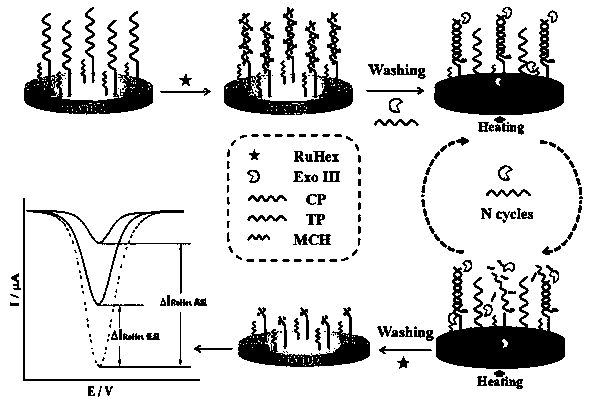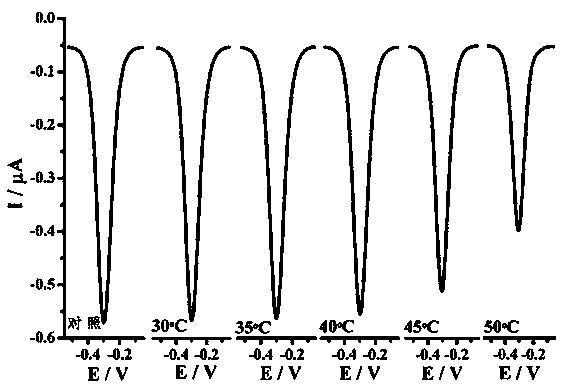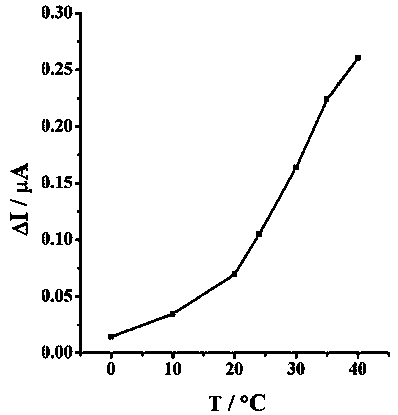A temperature-controllable electrochemical dna biosensor and its preparation method
A biosensor and electrochemical technology, which is applied in the field of biological analysis and nucleic acid detection, can solve the problems of enzyme molecular structure denaturation, difficult operation, poor enzyme activity, etc., and achieve high-sensitivity operation, rapid detection, and enhanced solution convection.
- Summary
- Abstract
- Description
- Claims
- Application Information
AI Technical Summary
Problems solved by technology
Method used
Image
Examples
Embodiment 1
[0033] A temperature-controlled exonuclease-based The preparation method of the electrochemical DNA biosensor of target cycle signal amplification, such as figure 1 shown, including the following steps:
[0034] (1) Design a capture probe DNA strand CP, the DNA strand CP is complementary to the target DNA strand TP, and can form a double-stranded structure with a 3' blunt end, inducing exonuclease III from the 3' of the double-stranded structure The blunt end digests the capture probe from the 3' end to the 5' end, thereby releasing the target DNA; the 5' end of the CP chain is thiolated, so that the CP is modified to the surface of the gold wire thermode through the gold-sulfur bond; among them, the capture probe CP The DNA sequence of the target DNA strand TP is: 5'-SH-(CH2)6-TTTTC TGTGC GCCGG TCTCT CCCA-3', the DNA sequence of the target DNA strand TP is: 5'-TGGGA GAGAC CGGCG CACAG AGGAAG-3';
[0035] (2) The gold wire thermal electrode is used on the suede with 0.05mm A...
Embodiment 2
[0039] To investigate the influence of temperature on the stability of gold wire thermode modified with capture probe CP, such as figure 2 As shown, the specific steps are as follows:
[0040] (1) Soak the thiolated capture probe-modified gold wire thermal electrode obtained in step (3) of Example 1 in a detection solution containing 10 mM Tris-HCl and 5 mM hexaammine ruthenium trichloride at a pH of 7.4, Then form a three-electrode system with silver silver chloride participating electrode and platinum wire contrast electrode, and perform SWV detection to obtain the initial SWV curve of ruthenium;
[0041] (2) Put the gold wire thermode modified with the thiol capture probe that has undergone the initial detection in the buffer solution containing 10mM Tris-HCl with a temperature of 30°C, 35°C, 40°C, 45°C, and 50°C and a pH of 7.4. Soak in the middle for 1h, after soaking, use SWV to detect in the ruthenium trichloride hexaammonium ruthenium detection solution, and obtain t...
Embodiment 3
[0043] To optimize the experimental temperature.
[0044] Only change the reaction temperature in step (4) of Example 1 from 0 to 40°C, and carry out experiments in turn, and other reaction conditions are the same as in Example 1; modify the thiol capture probe obtained in step (3) of Example 1 with CP The gold wire thermal electrode of the three chloride hexaammonium ruthenium detection solution carries out SWV detection, obtains the peak current I of ruthenium 0(RuHex) ; The electrochemical biosensor finally obtained in the embodiment 1 step (4) is detected in the detection solution of hexaammonium ruthenium trichloride with SWV, and the peak current of the obtained ruthenium is compared with the obtained I 0(RuHex) Take the absolute value of the difference: |ΔI RuHex |=|I RuHex -I 0(RuHex) | with |ΔI RuHex |Plotted against temperature, such as image 3 As shown, it can be seen that with the increase of temperature |ΔI RuHex | becomes larger, indicating that the increa...
PUM
 Login to View More
Login to View More Abstract
Description
Claims
Application Information
 Login to View More
Login to View More - R&D
- Intellectual Property
- Life Sciences
- Materials
- Tech Scout
- Unparalleled Data Quality
- Higher Quality Content
- 60% Fewer Hallucinations
Browse by: Latest US Patents, China's latest patents, Technical Efficacy Thesaurus, Application Domain, Technology Topic, Popular Technical Reports.
© 2025 PatSnap. All rights reserved.Legal|Privacy policy|Modern Slavery Act Transparency Statement|Sitemap|About US| Contact US: help@patsnap.com



